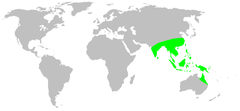Psechridae
| Psechridae | |
|---|---|
 |
|
| Fecenia cylindrata | |
| Scientific classification | |
| Kingdom: | Animalia |
| Phylum: | Arthropoda |
| Subphylum: | Chelicerata |
| Class: | Arachnida |
| Order: | Araneae |
| Infraorder: | Araneomorphae |
| Family: |
Psechridae Simon, 1890 |
| Genera | |
|
See text. |
|
| Diversity | |
| 2 genera, 24 species | |
 |
|
See text.
The Psechridae are a family of spiders with about 50 species in two extant genera, recently revised by Bayer (2011, 2012).
They belong to the RTA clade of spiders, spiders that all have a Retrolateral Tibial Apophysis on the male pedipalp. A recent phylogenetic analysis places Psechridae as close relatives of the Lynx spiders (Oxyopidae), as well as wolf spiders (Lycosidae) and nursery web spiders (Pisauridae) (Agnarsson et al. 2013). With body lengths of up to 2 cm and funnel webs more than 1 m in diameter, they are among the biggest cribellate spiders. Psechrids construct cribellate webs and Fecenia construct webs that are similar to orb webs of Orbiculariae spiders, a remarkable example of evolutionary convergence (Blackledge et al. 2012, Agnarsson et al. 2013). Psechridae spiders are only found in SE Asia, where they occur in forests from lowland to altitudes exceeding 2000 m. Female Psechrus carry their egg-sac in the chelicerae, similar to their relatives, the ecribellate Pisauridae. They feature several characteristics normally found in ecribellate spiders, for example brood care behavior, and a colulus with no apparent function (Fang et al. 2000).
Psechridae occur in forests, rocky areas, and caves, constructing horizontal webs lace webs (Psechrus) or pseudo-orbs (Fecenia). They have greatly elongated legs, with the last element being very flexible.
They occur in southeastern Asia, ranging from India in the west, to Solomon Islands in the east, reaching as far south as northern Australia, and north to central China.
...
Wikipedia
